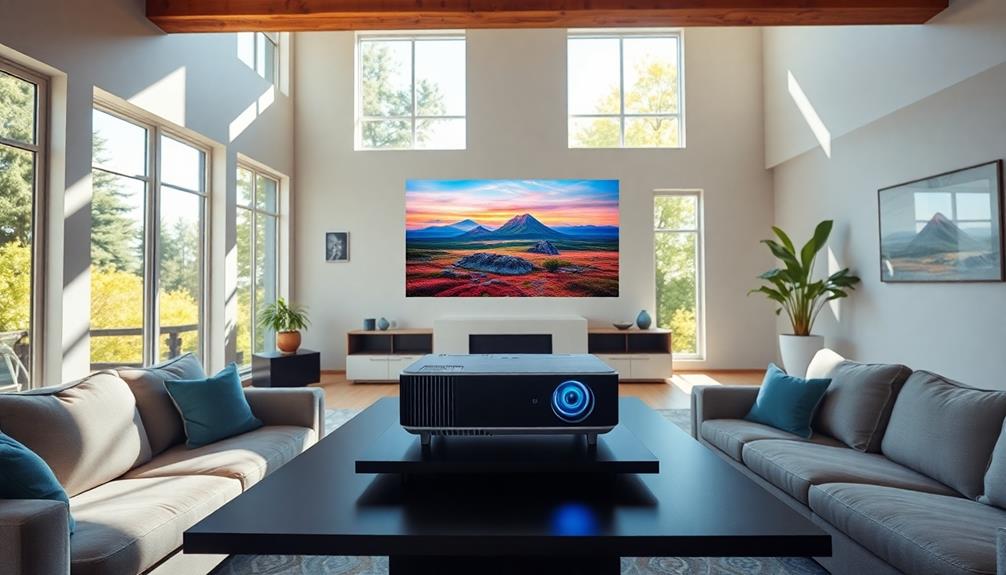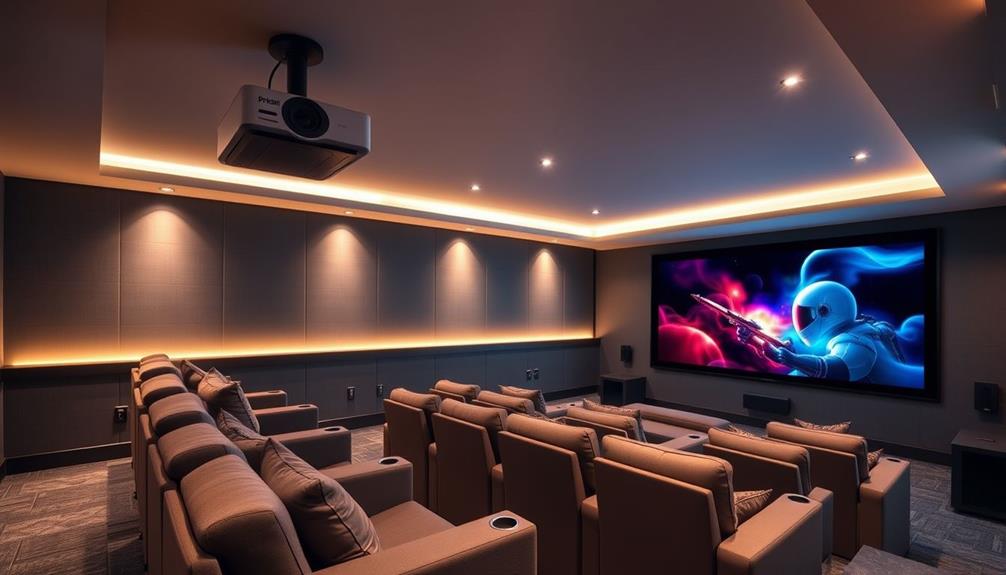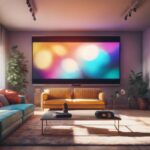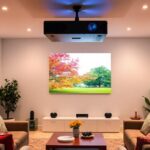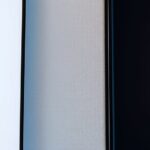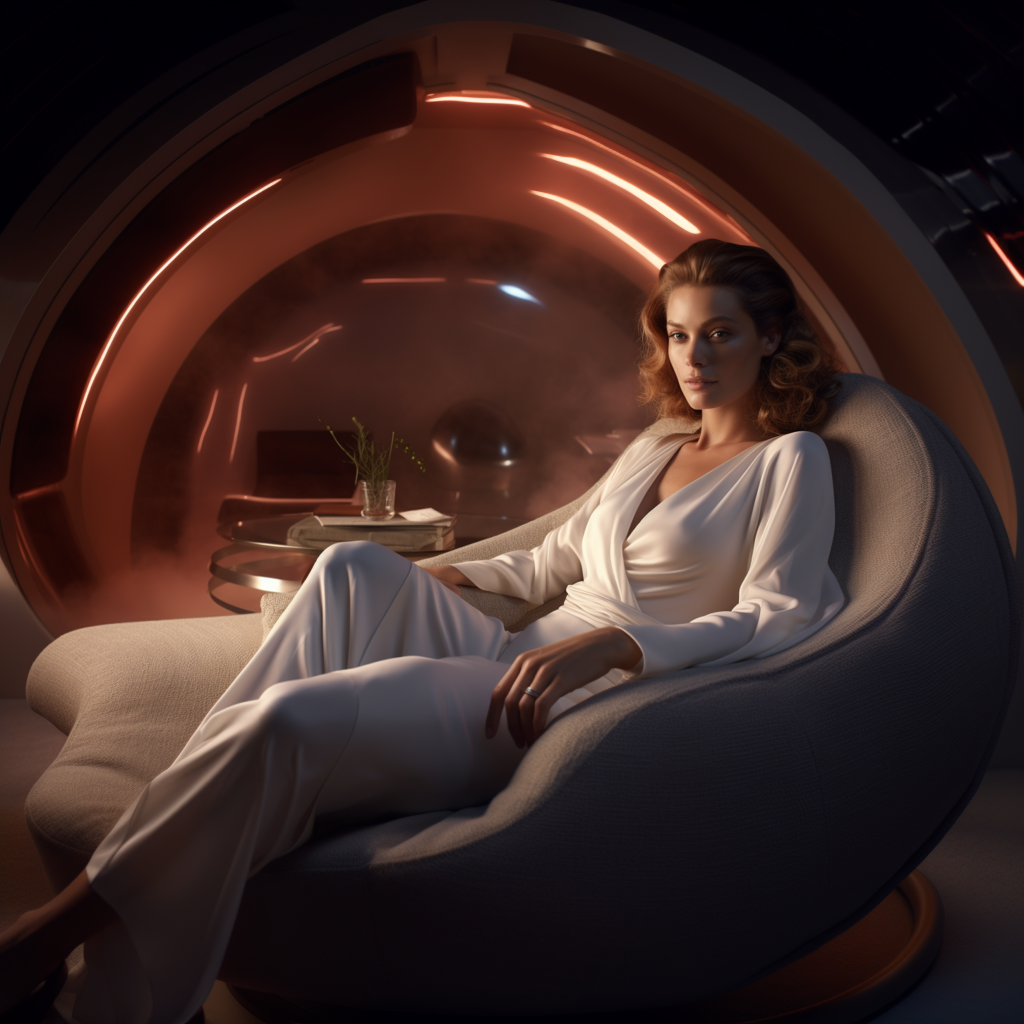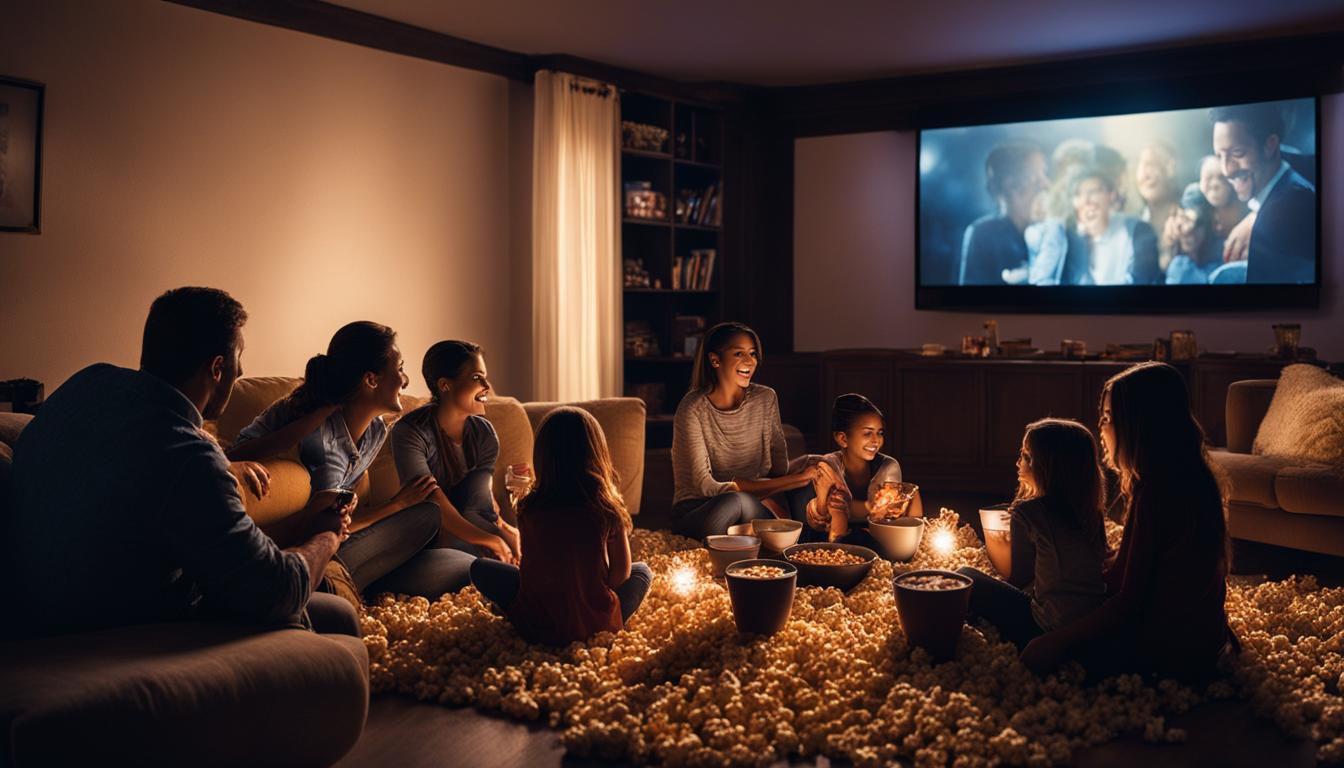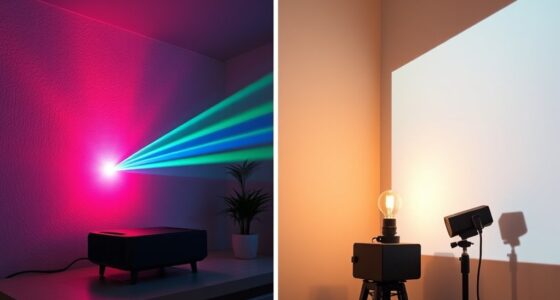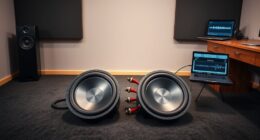To enjoy vibrant visuals in bright rooms, you should choose projectors with high brightness ratings, ideally between 3,300 to 5,000 lumens. Models like the Epson Home Cinema 880, BenQ TH585, and LG GRU510N excel against ambient light. Pairing these projectors with ambient light rejecting (ALR) screens can further enhance image quality. Make sure to evaluate your specific setup and features like streaming options and sound quality. Also, explore budget-friendly solutions like blackout curtains to manage light. There's plenty more to discover about the best options to transform your viewing experience in well-lit spaces.
Key Takeaways
- Choose projectors with brightness ratings between 1,500 and 5,000 lumens for optimal visibility in bright rooms.
- Ambient light rejecting (ALR) screens enhance image quality by reducing light interference and improving contrast.
- Key projector options include the Epson Home Cinema 880, BenQ TH585, and LG GRU510N, each suited for different brightness levels and prices.
- Utilize blackout curtains to control ambient light and enhance the projection experience in bright environments.
- Consider projector features like multiple HDMI ports, wireless streaming, and built-in audio for a versatile viewing setup.
Combatting Ambient Light

When it comes to combatting ambient light, you need to contemplate how it impacts your projector's performance. Ambient light considerably reduces image saturation, brightness, and overall visibility, making it essential to choose the right equipment.
If you're looking for a projector for a bright room, opt for a bright projector with a brightness range of 1,500 to 2,500 lumens. This guarantees you maintain image clarity and detail despite the surrounding light.
For even better performance, consider models that offer higher lumen outputs, like the Epson Home Cinema 880 or BenQ TH585, which boast up to 3,500 lumens. These projectors excel in bright environments, providing a more vibrant viewing experience.
Additionally, ambient light rejecting (ALR) screens can greatly improve image quality. These screens are designed to minimize interference from ambient light, enhancing contrast and color saturation in well-lit spaces.
If you're on a budget, utilizing blackout curtains is an affordable way to control ambient light and enhance your viewing experience.
Top Projector Models
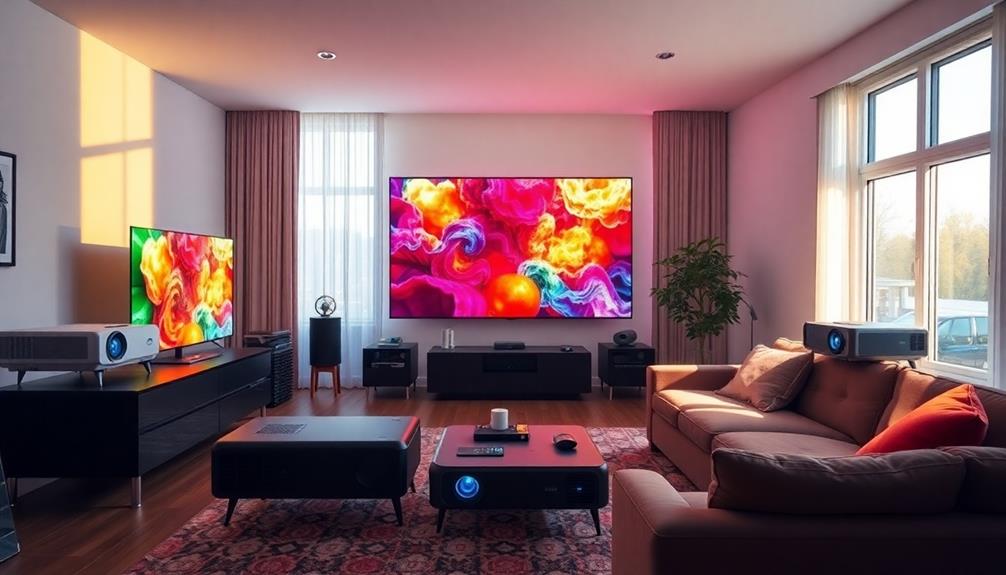
When choosing a projector for bright rooms, you'll want to evaluate key factors like brightness ratings and essential features.
Models like the Epson Home Cinema 880 and BenQ TH585 offer impressive lumens and versatile connectivity options, catering to various needs.
Let's compare these top models and assess their price and value to find the best fit for your space.
Brightness Ratings Comparison
Choosing the right projector for bright rooms hinges on understanding brightness ratings, which can greatly impact your viewing experience.
The lumens of brightness directly affect how well you'll see your content in environments with high ambient light. Here's a comparison of top models to take into account:
- Epson Home Cinema 880: With 3,300 lumens, it's an affordable option at $499, perfect for moderate brightness.
- BenQ TH585: Boasting 3,500 lumens, this projector excels in outdoor and brightly lit environments and features 8 preset picture modes for ideal viewing.
- BenQ TK850i: Offering 3,000 lumens, it guarantees vibrant 4K HDR images even in well-lit spaces, priced at $1,699.
- LG GRU510N: At an impressive 5,000 lumens, this model is ideal for extremely bright settings and features a laser light source, priced at $3,999.
When you're searching for the best projector for a bright room, take these brightness ratings into account.
They'll help you navigate ambient light challenges and guarantee your viewing experience remains enjoyable and vibrant.
Features and Connectivity Options
Understanding brightness ratings is just the beginning of selecting the right projector for bright rooms; features and connectivity options also play a significant role in enhancing your viewing experience.
For instance, the Epson Home Cinema 880 stands out with multiple HDMI connectivity options and Miracast support, making it versatile for various devices and streaming services.
If you value flexibility, the BenQ TH585 offers eight preset picture modes, allowing you to optimize your viewing experience in different ambient light conditions.
The BenQ TK850i takes it a step further by incorporating Android TV, giving you direct access to popular streaming services along with Chromecast and AirPlay for easy content casting.
The LG GRU510N provides a seamless wireless experience via Miracast and a WebOS browser, enabling you to stream effortlessly from multiple devices without cables.
Finally, the Epson Epiqvision LS500 simplifies setup with its quick assembly and no wires required, while delivering impressive 4,000 lumens brightness for bright environments.
These features and connectivity options are essential for creating an enjoyable viewing experience, even in challenging lighting conditions.
Price and Value Assessment
Evaluating the price and value of top projector models can greatly impact your decision-making process.
When you're considering projectors for bright rooms, it's crucial to balance your budget with the brightness and features that suit your needs.
Here's a quick look at some top models:
- Epson Home Cinema 880 – Priced at $499, it offers 3,300 lumens brightness, making it a solid choice for color accuracy in ambient light.
- BenQ TH585 – With 3,500 lumens and a price point ideal for beginners, it's perfect for outdoor movie nights.
- BenQ TK850i – If you want 4K resolution, this projector costs $1,699 and provides 3,000 lumens brightness along with Android TV streaming.
- LG GRU510N – At $3,999, it boasts 5,000 lumens brightness, ideal for high ambient light environments with a lifespan of 20,000 hours.
Each of these projectors offers distinct value, targeting different price ranges and brightness levels to suit your specific needs in bright rooms.
Make sure to weigh these factors carefully!
Sound and Audio Quality
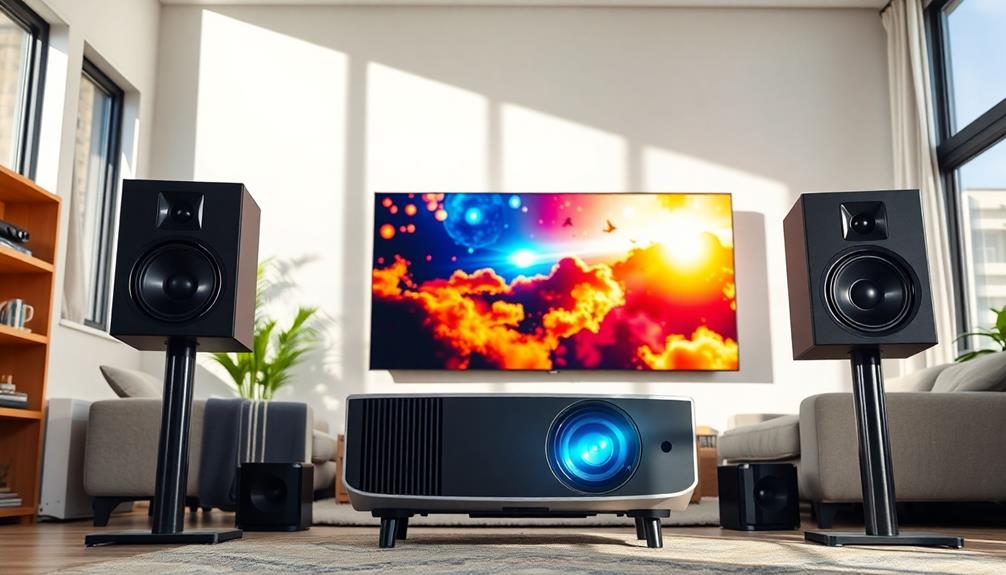
When it comes to sound and audio quality, projectors can often outperform flat-panel TVs, offering a richer viewing experience. Many projectors come equipped with integrated audio features that enhance your enjoyment of high-quality visuals. These built-in speakers are optimized for immersive sound, delivering clear audio that complements your favorite movies and games.
If you're seeking even better sound, consider connecting your projector to an external audio system. This compatibility allows you to elevate your home theater experience, especially in bright rooms where ambient light can diminish overall enjoyment. A superior sound system can make all the difference, turning a simple movie night into a cinematic experience.
Keep in mind that the quality of sound can also be influenced by speaker placement and room acoustics. Take the time to set up your projector in a way that maximizes audio performance.
Whether you're using integrated speakers or an external sound system, a thoughtful arrangement can greatly enhance your viewing experience. So, as you enjoy those high-quality visuals, don't underestimate the impact of great sound on your overall enjoyment!
Streaming and Connectivity
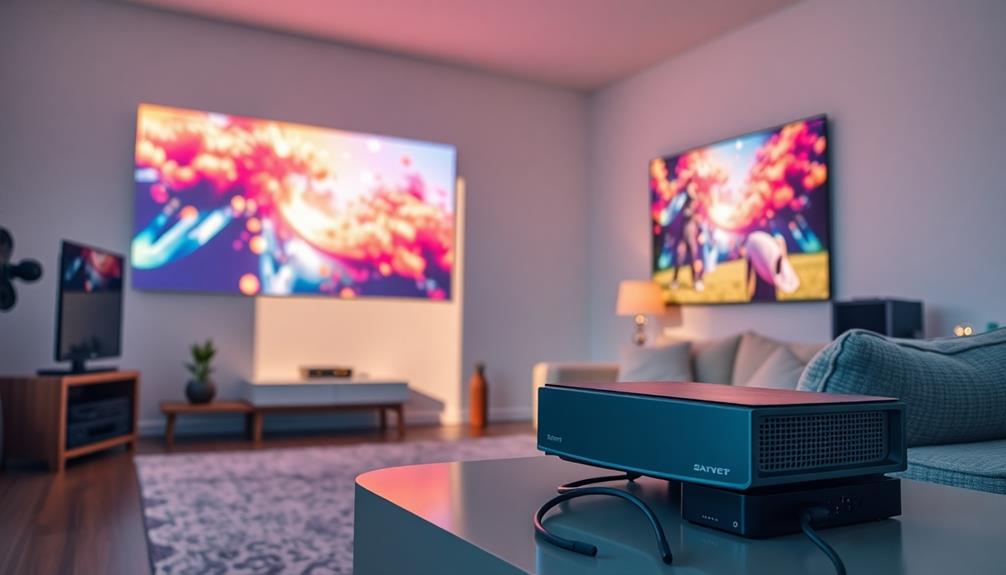
Streaming and connectivity are essential features that can elevate your projector experience to new heights. With many modern projectors, like the BenQ TK850i and LG GRU510N, you can access a world of content directly through Android TV. This means no more fumbling with external devices just to watch your favorite shows.
Here are four key aspects that enhance your streaming and connectivity experience:
- Multiple HDMI Ports: Connect various devices—like gaming consoles or cable boxes—without hassle.
- USB Connections: Easily plug in flash drives for instant access to your media files.
- Voice Search: Navigate effortlessly using Google Assistant, making it simple to find what you want to watch.
- Wireless Content Access: Enjoy seamless streaming from your devices with technologies like Miracast and Chromecast.
These features guarantee that you can immerse yourself in your favorite streaming services, such as Netflix and Hulu, with minimal effort.
The extensive availability of apps assures you'll never run out of entertainment options, making your projector a central hub for all your viewing needs.
Comparison With Traditional TVS
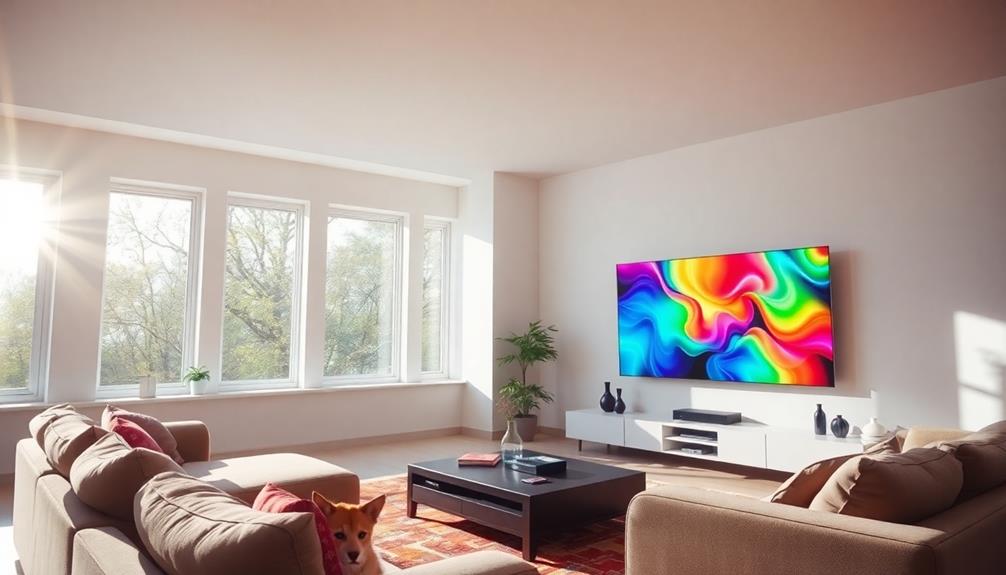
When you're choosing between projectors and traditional TVs for bright rooms, brightness performance is a key factor.
Projectors can deliver considerably higher lumens, making them much more effective in well-lit spaces compared to TVs with lower nits.
Additionally, understanding the efficiency of heat pumps can provide insights into how to optimize energy use in your home.
Plus, the picture quality can be enhanced by features like Ambient Light Rejecting screens, giving you a clearer and more vibrant viewing experience.
Brightness Performance Comparison
In bright environments, projectors outshine traditional TVs in brightness performance, making them a superior choice for those seeking vibrant visuals.
When you consider ANSI lumens, projectors typically range from 1,500 to 5,000 lumens, while traditional TVs max out at 1,000 nits. This notable difference guarantees that you get clearer images even in ambient light.
Here's a quick comparison:
- Brightness Levels: Projectors like the BenQ TH585 deliver 3,500 lumens, considerably improving visibility in well-lit rooms.
- Larger Screen Sizes: Projectors can display images up to 120 inches, compared to the 85-inch maximum of most TVs.
- Color Accuracy: High-lumen projectors, such as the Epson Home Cinema 880 with 3,300 lumens, offer better color saturation than traditional TVs.
- ALR Screens: Utilizing Ambient Light Rejecting (ALR) screens enhances image quality in bright settings, giving projectors a distinct edge over flat-panel TVs.
With this brightness performance comparison, it's clear that projectors are the ideal choice for enjoying incredible visuals in any lighting condition.
Picture Quality Differences
Enhancing your viewing experience, projectors designed for bright environments markedly outperform traditional TVs in picture quality. With models like the Epson Home Cinema 880 and BenQ TH585, you get superior color accuracy and brightness, even in ambient light.
Here's a quick comparison of key features:
| Feature | Projector for Bright Rooms | Traditional TVs |
|---|---|---|
| Brightness Levels | 1,500 – 5,000 lumens | 300 – 1,000 lumens |
| ALR Screens | Yes | No |
| Screen Size | Up to 120 inches | Up to 85 inches |
Projectors excel in brightness levels, ensuring vivid imagery even in daylight. The advanced Ambient Light Rejecting (ALR) screens further enhance picture quality by reducing light interference, a benefit traditional TVs lack. Additionally, the larger screen size of projectors creates a more immersive viewing experience, drawing you into the action.
Users consistently report that projectors can outperform TVs in bright rooms, making them an ideal choice for anyone looking to elevate their home entertainment setup. If you want to enjoy movies or sports during the day, a projector for a bright room is the way to go.
Projector Options for Bright Environments
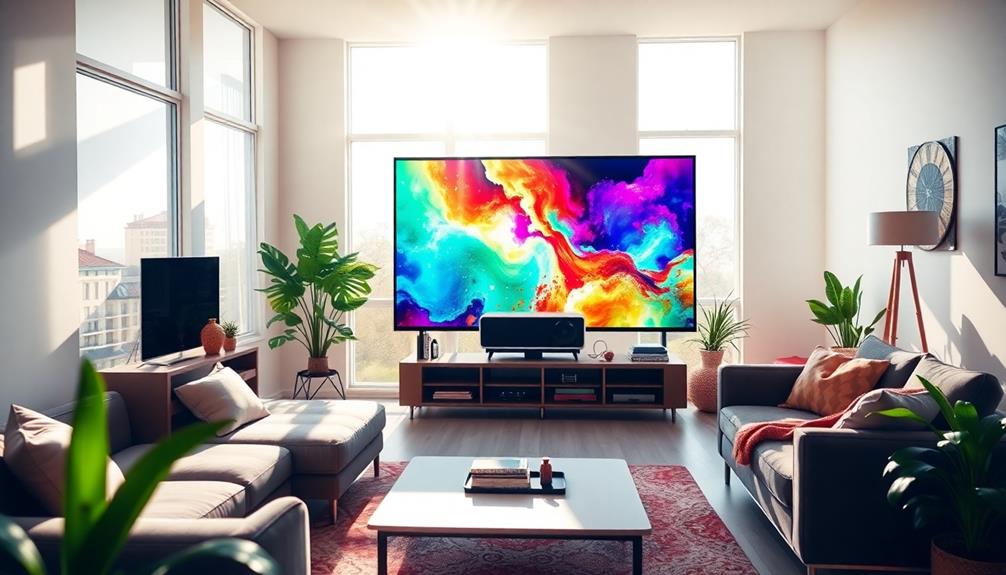
Finding the right projector for bright environments can greatly enhance your viewing experience. When you're battling ambient light, choosing the right model is essential.
Here are some top projector options that excel in well-lit rooms:
- Epson Home Cinema 880 – With 3,300 lumens, it delivers sharp, vibrant images even during the day.
- BenQ TH585 – Offering 3,500 lumens, this projector guarantees clear visuals, perfect for bright settings.
- LG GRU510N – This powerhouse boasts a laser light source with 5,000 lumens, providing exceptional performance for up to 20,000 hours.
- Epson Epiqvision LS500 – At 4,000 lumens, it maintains image quality while delivering a stunning viewing experience.
Additionally, consider pairing your projector with an ALR (Ambient Light Rejecting) screen. This screen greatly reduces light interference, enhancing your projector's performance in bright environments.
If you want vivid colors and details, options like the BenQ TK850i, which combines 3,000 lumens with 4K HDR capability, are also great.
With these choices, you'll overcome ambient light challenges and enjoy your movies and presentations to the fullest.
Screen Considerations
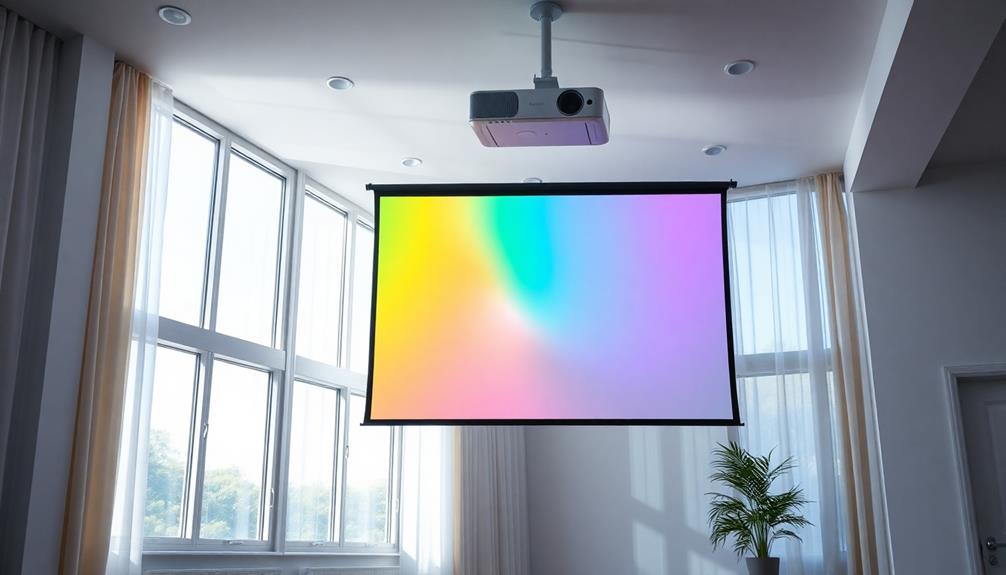
Selecting the right screen can greatly improve your projector's performance in bright rooms. When dealing with ambient light, an Ambient Light Rejecting (ALR) screen is your best bet. These screens are designed to minimize light interference, enhancing contrast and delivering vibrant images, even in well-lit spaces.
Look for ALR screens with gain ratings between 0.8 and 1.4; they strike a balance between brightness and viewing angle, making them effective for mixed-use rooms. Additionally, consider opting for screens that complement the latest kitchen appliance trends for a cohesive aesthetic in your entertainment area.
If you prefer an alternative, grey screens can outperform standard white screens in bright conditions. They provide better contrast and color fidelity, which is vital for maintaining image quality during daytime use.
Consider your setup needs, too. If you plan to have speakers behind the screen, an Acoustic Transparent (AT) screen allows sound to pass through without sacrificing image quality, though positioning is key for best results.
For added convenience, pull-down ALR screens offer flexibility for casual viewing, allowing you to easily switch between setups for daytime and nighttime use.
Choosing the right screen is essential for maximizing your projector's potential in bright rooms.
Setup and Configuration
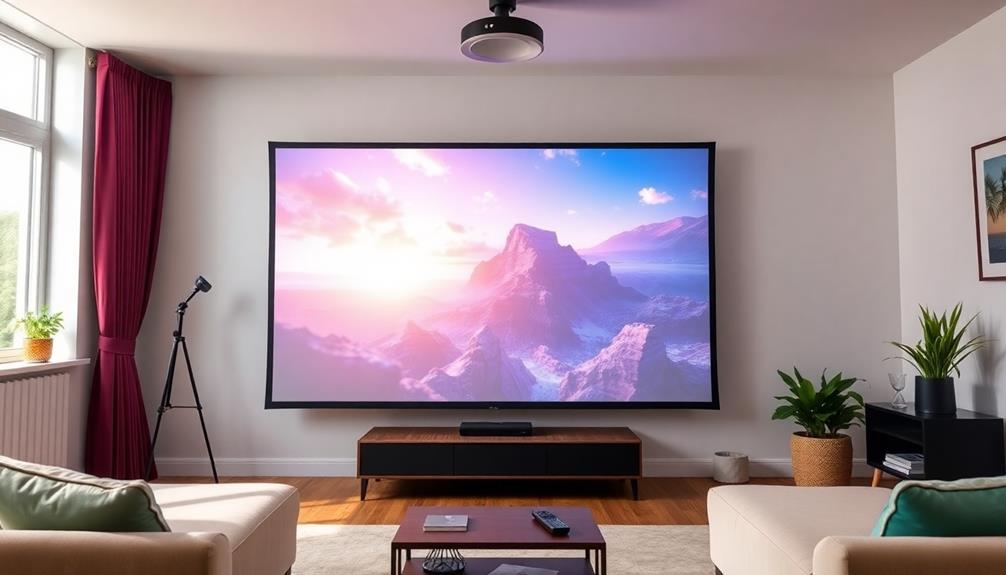
To achieve the best viewing experience in bright rooms, you need to carefully consider your projector's setup and configuration.
Start by focusing on the projector's brightness. Look for models like the Epson Home Cinema 880 with 3,300 lumens or the BenQ TH585 at 3,500 lumens to combat ambient light.
Next, here's a handy checklist for your setup:
- Choose an Ambient Light Rejecting (ALR) screen to enhance image quality and minimize interference from natural light.
- Select the right projector throw type; ultra-short throw projectors like the Optoma GT5600 can project large images from just 0 to 4 feet away, perfect for smaller spaces.
- Manage your room lighting by using blackout curtains or painting walls in darker shades to reduce washout effects.
- Plan for cable management to keep your setup neat and guarantee easy access for future upgrades.
Budgeting for Home Theater
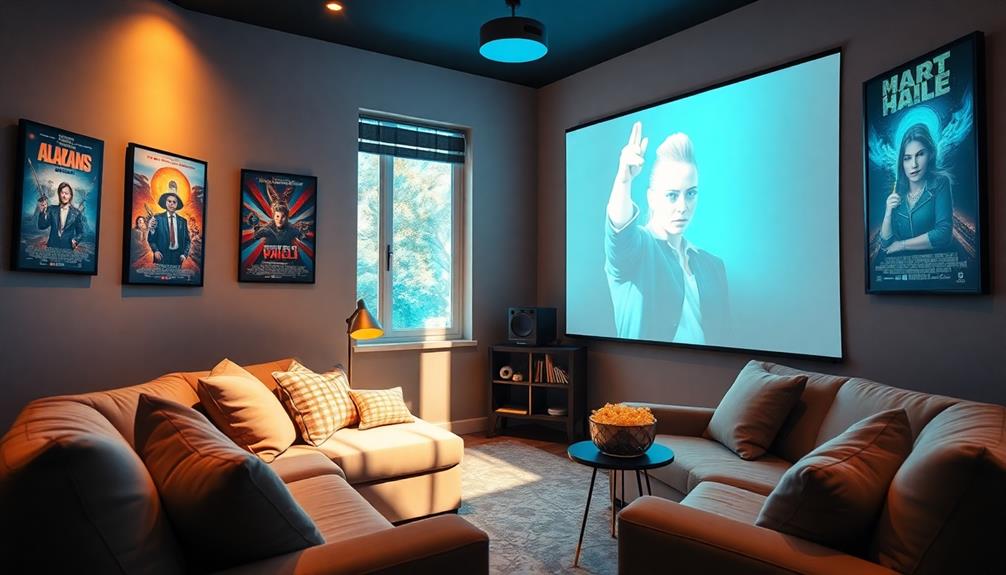
Budgeting for a home theater can seem intimidating, but breaking it down into manageable parts makes it easier. Aim for a total budget of around $10,000 for your setup, which includes audio, video, and screen costs.
When it comes to the projector and screen, try to keep your budget under $5,000, but be flexible if you find a higher-quality option that fits your needs. Consider investing in Ambient Light Rejecting (ALR) screens, as they can markedly enhance image quality in bright environments, even if they're pricier than standard options.
Make sure to factor in additional costs for audio equipment and any accessories you might need to complete your home theater experience. Ensuring compatibility with your projector is vital to avoid future headaches.
Lastly, remember to account for potential upgrades in projector technology or screen sizes. Investing a bit more now could save you money later, as advancements can greatly improve your viewing satisfaction.
Frequently Asked Questions
What Color Projector Screen Is Best for Bright Room?
For bright rooms, choose a dark grey or charcoal screen. These colors enhance contrast and minimize ambient light impact, resulting in richer colors and improved image quality, making your viewing experience much more enjoyable.
How to Choose a Projector for a Bright Room?
Choosing a projector for a bright room is like finding a lighthouse in a storm. You'll want high lumens, an excellent contrast ratio, and versatile connectivity. Don't forget to take into account screen type for ideal viewing!
How Many Lumens for a Projector in a Bright Room?
For a projector in a bright room, you'll want at least 1,500 to 2,500 lumens. Higher brightness, like 3,000 lumens or more, really enhances your viewing experience in direct light conditions.
What Projector Works Best in Daylight?
When you're looking for a projector that works best in daylight, consider options like the LG GRU510N or Epson EpiqVision LS500. Their high lumens guarantee clear, vibrant images even in bright environments.
Conclusion
In bright rooms, you don't have to settle for dim, washed-out images. By choosing the right projector and considering screen options, you can create a vibrant viewing experience that rivals an old-timey movie theater. Remember to pay attention to audio quality and connectivity for a seamless setup. With the right tools and a bit of planning, you'll transform your space into a home theater that shines, no matter how bright the sun gets outside.
Hi, I’m Dominique. I love movies and want everyone to have the best home cinema experience possible. That’s why I started 1home Theatre Projector. We help people build their home cinema system using the latest technology and news on laser tv and all-around home entertainment.
We’re a small team of movie buffs (and experts) who are passionate about giving our readers the best advice and information possible. So whether you’re just starting out or you’re looking to upgrade your home cinema system, we’ve got you covered!
